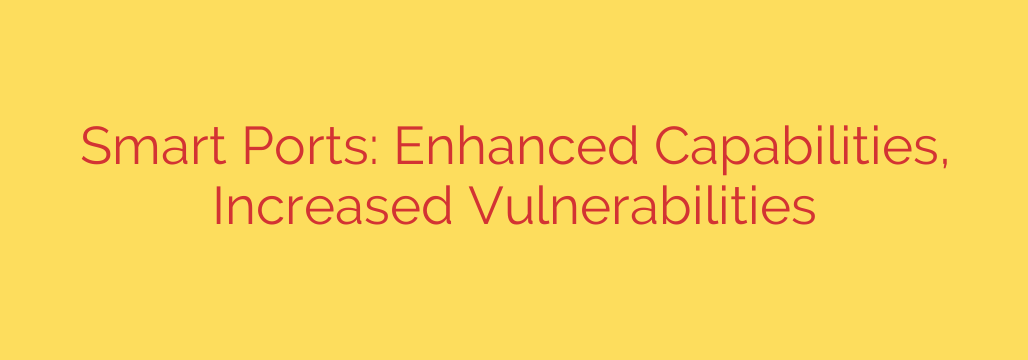
Smart Ports: Navigating the Future of Global Trade and Its Rising Cyber Threats
The world’s ports are the lifeblood of the global economy, the critical junctions through which nearly 90% of trade flows. For centuries, their operations remained largely unchanged. But today, a technological revolution is underway, transforming these traditional maritime hubs into highly efficient, automated, and interconnected “smart ports.”
This digital transformation promises unprecedented gains in speed, reliability, and cost-effectiveness. However, with these enhanced capabilities comes a new and significant risk: a vastly expanded vulnerability to cyberattacks. Understanding this double-edged sword is crucial for securing the future of global commerce.
What Exactly Is a Smart Port?
A smart port uses a suite of advanced technologies—like the Internet of Things (IoT), Artificial Intelligence (AI), and 5G—to automate and optimize its operations from end to end. Think of it as the port’s central nervous system becoming fully digital.
Instead of manual processes and paper-based tracking, a smart port leverages real-time data to streamline every action. Key benefits include:
- Enhanced Efficiency: Automated cranes can load and unload ships faster, AI-powered logistics systems can predict the best routes for trucks and cargo within the port, and digital platforms can clear customs in minutes instead of days.
- Reduced Costs: Automation lowers labor costs, predictive maintenance on equipment prevents costly breakdowns, and optimized fuel consumption for ships and vehicles saves money.
- Improved Safety and Security: Sensor networks can monitor for safety hazards, and digital tracking provides a clear, unalterable record of cargo movement, reducing theft and loss.
The Technology Powering the Transformation
Several key technologies work in concert to make a smart port possible:
- The Internet of Things (IoT): This is the foundation. Sensors are placed on virtually everything—shipping containers, cranes, vehicles, and infrastructure. These sensors constantly transmit data on location, status, temperature, and more, creating a complete, real-time picture of the entire port.
- Artificial Intelligence (AI): AI algorithms analyze the massive amounts of data collected by IoT devices. This allows for predictive analytics for equipment maintenance, optimization of container stacking, and intelligent traffic management to prevent bottlenecks.
- 5G Connectivity: The sheer volume of data in a smart port requires ultra-fast, reliable, and low-latency communication. 5G provides the wireless backbone needed for thousands of devices to communicate with each other and with central systems instantly.
- Blockchain: For transactions and cargo tracking, blockchain offers a secure and transparent digital ledger. Every step in a container’s journey can be recorded on an immutable chain, preventing fraud and providing all stakeholders with a single source of truth.
The Dark Side: A Widening Attack Surface
While this intricate web of technology drives efficiency, it also creates countless new entry points for malicious actors. Every connected sensor, automated vehicle, and software platform is a potential target. The convergence of Information Technology (IT) and Operational Technology (OT) is the single biggest risk. In the past, a hack on a port’s IT systems might steal data. Today, that same hack could potentially cross over to the OT systems that control physical machinery.
The potential consequences are staggering:
- Ransomware Attacks: Hackers could lock down a port’s entire operating system, halting all cargo movement and demanding a massive ransom to restore functionality. This could paralyze supply chains for weeks.
- Data Breaches and Espionage: Sensitive data about cargo contents, shipping routes, and national trade could be stolen and sold to competitors or hostile nations.
- Physical Disruption and Sabotage: A successful attack could be used to manipulate automated cranes, causing them to drop containers or collide with ships. Navigational systems could be altered, leading to vessel collisions, or refrigerated containers could be remotely shut down, spoiling valuable goods.
The 2017 NotPetya cyberattack, which hit the shipping giant Maersk, serves as a stark warning. The attack crippled the company’s global operations for weeks, leading to an estimated $300 million in losses and demonstrating how quickly a digital threat can cause massive physical and financial disruption.
Actionable Security Strategies for a Resilient Port
Securing a smart port is not an afterthought—it must be a foundational principle. The goal is cyber-resilience, the ability to anticipate, withstand, and recover from an attack. Here are essential security measures every port must implement:
- Adopt a “Security by Design” Approach: Cybersecurity cannot be bolted on after a system is built. It must be integrated into the architecture of every new technology and process from the very beginning.
- Conduct Comprehensive Risk Assessments: Ports must regularly perform penetration testing and vulnerability assessments to identify and patch weaknesses in both their IT and OT systems. This includes testing everything from crane software to employee phishing awareness.
- Promote Collaboration and Information Sharing: A port is an ecosystem of different entities—port authorities, shipping lines, logistics companies, and government agencies. These groups must collaborate and share threat intelligence to present a united defensive front.
- Invest in Employee Training: Humans are often the weakest link in the security chain. Regular, mandatory training on topics like phishing, social engineering, and proper data handling is non-negotiable for all personnel.
- Develop a Robust Incident Response Plan: It’s not a matter of if an attack will happen, but when. Having a well-rehearsed plan that outlines exactly how to detect, contain, and recover from a breach is critical to minimizing downtime and damage.
Smart ports represent the undeniable future of global logistics. Their potential to create a more efficient, cost-effective, and sustainable trade ecosystem is immense. However, this future can only be realized if we build it on a secure foundation, ensuring that our digital advancements do not become our greatest vulnerabilities.
Source: https://www.helpnetsecurity.com/2025/07/23/ccdcoe-maritime-port-cyber-attacks/








